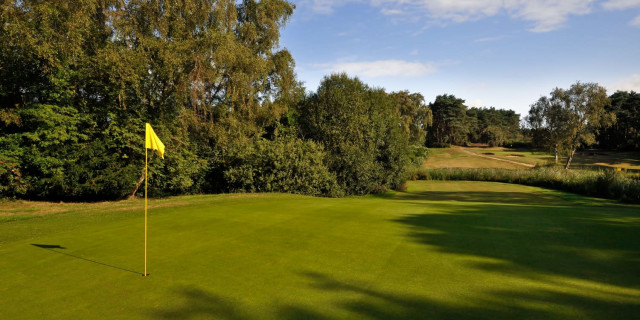Feature Review: La Manga Club – South Course
Feature review from Nick Bonfield who recently took a golf trip to Murcia playing the courses in the region, read Nick's blog online via The Golf Debate and follow Nick on Twitter via @thegolfdebate
 La Manga Club, located twenty minutes away from Murcia San Javier Airport, is a well renowned and highly regarded resort. It is home to luxurious villas, professional tennis camps, high quality cricket and football facilities, and a diverse range of bars and restaurants. Quality is synonymous with the resort as a whole, and the golf on offer is no exception.
La Manga Club, located twenty minutes away from Murcia San Javier Airport, is a well renowned and highly regarded resort. It is home to luxurious villas, professional tennis camps, high quality cricket and football facilities, and a diverse range of bars and restaurants. Quality is synonymous with the resort as a whole, and the golf on offer is no exception.
There are three courses at La Manga Club - the North, South and West - and each one deserves to be labelled as one of the best courses in the region of Murcia. The West is one of the tightest, most challenging courses that I have ever played, winding its way through hills and areas of dense forest. The North is more open and scoreable, but multiple water hazards, trees and barrancas litter the course. The South – host of the European Tour’s Spanish Open in 1975 – is similar to the North in layout and difficulty, and provides another excellent and enjoyable test of golfing aptitude. Pay well and there are opportunities; play badly, and it is perfect feasible to record an embarrassingly high score.
The practice facilities are second to none. An enormous driving range with more than 40 bays sits alongside multiple putting and chipping greens. The excellence of the practice facilities is matched by the courses, and the South (and indeed the others) is very difficult to fault.
La Manga South Course
The course is quite open, but stray significantly off line and you will be punished by lakes and strategically placed bunkers and barrancas. The course finds the perfect balance between providing a difficult test and ensuring that good play is rewarded and low scores are achievable.
The greens are quick, smooth and true, making putting a very enjoyable test. As is so often the case in Spain, the putting surfaces are sizeable, with some easily 100 yards from front to back. Putting is the key to scoring well on the South course. It is fairly long, but the fairways are generous, and many of the holes play downhill.
The first hole is a fairly straightforward – albeit long – uphill par four. Approaches are hit with a long iron to a sizeable green surrounded by bunkers.
The second hole is a long, difficult par three. Waters lurks to the right, waiting to catch any tee shot that is pushed, and bunkers protect the front of the green. To find the putting surface, tee shots must carry in excess of 160 yards, leaving a difficult and potentially sizeable putt. Par is a good score.
The third hole is another uphill par four, with out of bounds both left and right, before the first par five on the course. The fourth is an exceptional golf hole. Trees and out of bounds line the left hand side of the hole, with another hazard on the right hand side of the hole. A strategically places fairway bunker adds to the difficulty of finding the fairway. There is little to no prospect of finding the green in two, thanks largely to a large pond protecting the putting surface. A good lay-up will leave a wedge for the third, but the green is narrow, anything slightly short will fall back into the water, and further danger lurks both long and right. The green itself is tiered and treacherous, and about 120 feet from left to right.
The fifth is another tricky par three. Water and marshland down the right hand side merge into a sizeable greenside bunker. Anything hit slightly left may hit a slope and run out of bounds or into a barranca.
The sixth is the second par five on the course. The hole plays significantly downhill and from right to left. A big drive with a favourable bounce can make its way down towards the flat part of the fairway, with the green just about in range. The vast majority will be presented with a difficult lay-up. The fairway narrows significantly leading up to a barranca 100 yards short of the green, with a big bunker left and a water right. Another big, undulating green makes a three putt a distinct possibility.

Seven is a short par four, but a very tough driving hole. Drives are hit over a barranca, with dense vegetation right and trees and water left. Approaches are hit downhill to a well protected green that slopes from back to front.
Eight is an uphill, mid-range par four, and nine another par downhill par five that swings from right to left.
The tenth is a wonderful par four. The hole plays straight until turning 90 degrees left around the 220 yard mark. Out of bounds runs all the way down the left, with trees and barrancas right. The drive is made even narrower by the presence of a large bunker as the hole starts to turn left. A good drive will leave a short iron to one of the flattest greens on the course.
Eleven is a difficult par four. The fairway is wide, but the approach must be played with a mid to long iron to a green guarded by an enormous body of water. Anything hit slightly fat or right will find the lake, and anyone hoping to lay-up must find a tiny area of grass to the left of the pond. The green is multi-tiered and slopes considerably from left to right. Anyone making par here will be thrilled.
The twelfth is a short but daunting par three. It is no more than an eight iron, but water surrounds the green. Anything hit too long will run off the back of the green and find another water hazard.
Thirteen is a long but relatively straightforward par five, despite out of bounds all the way down the left hand side of the hole.
Fourteen is a short par four. A waste bunker on the right hand side of the fairway runs the length of the hole, making accuracy off the tee paramount. The second shot is played with a short iron and birdies are available, especially when the pin is positioned in a slight gully in the middle of the green.
Fifteen is a long, downhill par four, and approaches must clear a wide barranca that dissects the fairway some 50 yards short of the green. Sixteen is similar in layout but shorter, with the barranca being replaced by another sizeable body of water.
Seventeen is a long par three with water right, before the closing par five 18th. Drives must be hit around a fairway bunker and between large ponds that flank both sides of the fairway. The lay-up area is fairly generous, and birdies are on offer if the fairway is found with the second. Third shots are played over another large barranca to an enormous, multi-tiered green.
The south course at La Manga is a beautifully designed course that will present a challenge to all standards of golfer.
To find out more about the Murcia region and golf click here.
For more information or to book call 00 34 968 17 5577, email reserve@lamangaclub.com or go to www.lamangaclub.com.
Related Content:

















